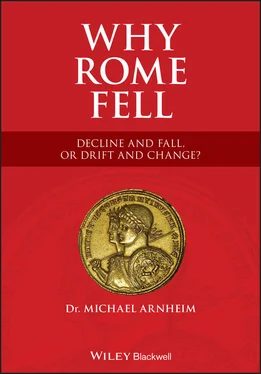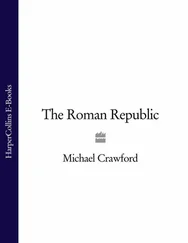Michael Arnheim - Why Rome Fell
Здесь есть возможность читать онлайн «Michael Arnheim - Why Rome Fell» — ознакомительный отрывок электронной книги совершенно бесплатно, а после прочтения отрывка купить полную версию. В некоторых случаях можно слушать аудио, скачать через торрент в формате fb2 и присутствует краткое содержание. Жанр: unrecognised, на английском языке. Описание произведения, (предисловие) а так же отзывы посетителей доступны на портале библиотеки ЛибКат.
- Название:Why Rome Fell
- Автор:
- Жанр:
- Год:неизвестен
- ISBN:нет данных
- Рейтинг книги:3 / 5. Голосов: 1
-
Избранное:Добавить в избранное
- Отзывы:
-
Ваша оценка:
- 60
- 1
- 2
- 3
- 4
- 5
Why Rome Fell: краткое содержание, описание и аннотация
Предлагаем к чтению аннотацию, описание, краткое содержание или предисловие (зависит от того, что написал сам автор книги «Why Rome Fell»). Если вы не нашли необходимую информацию о книге — напишите в комментариях, мы постараемся отыскать её.
Why Rome Fell: Decline and Fall, or Drift and Change?
Why Rome Fell
Why Rome Fell
Why Rome Fell — читать онлайн ознакомительный отрывок
Ниже представлен текст книги, разбитый по страницам. Система сохранения места последней прочитанной страницы, позволяет с удобством читать онлайн бесплатно книгу «Why Rome Fell», без необходимости каждый раз заново искать на чём Вы остановились. Поставьте закладку, и сможете в любой момент перейти на страницу, на которой закончили чтение.
Интервал:
Закладка:
But Caracalla’s policy of inclusiveness stopped short of inviting whole “barbarian” tribes to settle. In 213, for example, the highly Romanized Alemanni broke through the northern frontier of the Roman Empire with a view to settlement. Far from welcoming these would-be migrants, Caracalla pushed them back and strengthened the frontier against them. Why was the imperial government unable to hold back the “barbarians” who were similarly attracted to Roman civilization in the fourth and fifth centuries? And why did the West fall while the East survived?
The answer lies partly in the sheer strength of numbers involved in these later “barbarian” incursions, possibly driven by pressure on themselves by a westward push from the Huns. Deterred by Constantinople’s strong strategic position and fortifications, the “barbarians” diverted their efforts to the West.
Divided Loyalties in a Fractured Society
However, the answer to our question must be sought largely in internal factors, and, in particular, in the divided loyalties of a fractured society, exactly the opposite of Gibbon’s “indissoluble union and easy obedience” of the first two centuries of the Principate. The sentiment expressed in the famous line by Horace (65–8 BCE), Dulce et decorum est pro patria mori (It is sweet and fitting to die for your country), was probably widely shared during the Pax Romana (the Roman Peace) of the same period. (Horace Od . 3.2.)
When we come to the fourth century, we even hear of young men cutting off a thumb to beat the “draft.” Judging by the number of laws against this practice, it may not have been as rare as modern writers tend to believe, and it so infuriated Valentinian I that, in 368, he ordered offenders to be burned alive. (CTh. 7.13.5.) There is no shortage of evidence of the unpopularity of conscription among the men themselves, and also among the large landowners whose duty it was to provide recruits.
The sack of Rome by the Goths in 410 and the Vandals in 455 elicited a great outpouring of grief among Christians and pagans alike, yet loyalty to the regime was generally so low among its subjects that the “barbarian” incursions generally met with very little resistance. This was the case even though the senatorial aristocracy undoubtedly benefited from having an overarching imperial structure in the West, enabling them to continue to combine office, land, and wealth in several provinces at the same time, which, however, effectively made them a centrifugal force. But, with their fortified estates, especially in Gaul, their disinclination to pay taxes, and their gradual control over the Church, many of them preferred to curry favor with their new masters rather than to attract their ire.
“The madness of the heretics must be curbed” (CTh 16.5.65.)
Contrary to the frantic efforts of some modern writers, until Christianity became dominant with imperial favor under Constantine and his successors, the Roman Empire enjoyed not only religious toleration but indeed freedom of worship and religion. (See Chapter 10.)
The religious intolerance and persecutions instituted by the Christian Roman Empire, in East and West alike, fractured this unity. Even before 380, when Christianity became the exclusive official religion of the Empire, all those who were not adherents of that religion—and of its dominant denomination—found themselves the targets of incessant attacks, which sometimes spurred them into active disobedience. The usurper Firmus was able to hold out against the imperial government in Africa between 372 and 375, with the support of the Donatists, a “heresy” that was particularly popular in that area. The ousting of the Eastern Emperor Zeno by Basiliscus in 475 was achieved with the support of another group of “heretics,” the Monophysites, who were very strong in Egypt and Syria, and who sided with the Muslims in their conquest of Egypt (639–646.) It is clear, from among other things, the long saga of the Altar of Victory, that there were a good many pagans in the aristocracy up to and beyond the end of the fourth century. It is significant that Eugenius, the puppet emperor chosen by Arbogast with the support of the Senate in 392, made a point of restoring the Altar of Victory to its place in the Senate house and appointed the influential pagan aristocrat Virius Nicomachus Flavianus as praetorian prefect of Italy. Significantly, Priscus Attalus, selected by the Visigoths as emperor in 409 and again in 414, was a pagan. Some modern writers, in their concern to kill off paganism as early as possible, have gone out of their way to disprove the existence of an active pagan resistance in the late fourth century. Yet pagans did not need to be activists in order to feel less than loyal toward an intolerant, persecuting government. And, though supposedly extinguished by 423, paganism clearly continued to have considerable numbers of adherents for a long time thereafter. As late as the reign of Justinian (527–565), John of Ephesus boasted of converting 70,000 pagans in Asia Minor, one of the most Christianized parts of the Empire, and, in addition, a large number of pagans, including some highly placed men, in Constantinople itself, which had been established as a Christian capital by Constantine in 330.
The poisonous religious atmosphere of the fragmented society that was the Christian Roman Empire helps to explain the divided loyalties that weakened the West in the face of the “barbarian” invasions and also the loss to the East of the bulk of its territory to the Muslims in the seventh century (some of which was, however, reconquered in the ninth and tenth centuries, only to be permanently lost in the aftermath of the Battle of Manzikert of 1071.)
So What?
How significant, then, was the “fall” of the western empire after all? In other words, what difference does it make whether the West fell, was pushed, or never came to an end at all? My own view is that the importance of this question has been grossly exaggerated. All the time and effort spent on the question of the fall of the Roman Empire could have been far better spent on the related, but quite separate, question of continuity and change. (See Chapter 5.)
East Is East, and West Is West
The significance of this question becomes all the more apparent by comparing continuity and change in the West with those same features in the East. Though what is now generally called the Byzantine Empire lasted over a thousand years (albeit for quite some time in a very shrunken state), its heritage is rather restricted. The only territory that can be considered a linear descendant of Byzantium in the modern world is that now occupied by Greece and the Greek-speaking part of Cyprus. In these two states alone is Greek the official language spoken as their first language by the population at large. This is a major negative feature. Though the Byzantines always thought of themselves as “Romans” (and Orthodox Christians are still referred to in Turkish as Rûm ), their empire was essentially a Greek empire. From the time of Alexander the Great (356–323 BCE), Greek became the lingua franca of the Eastern Mediterranean even though Roman rule made Latin the official language of the whole Roman Empire until it was replaced in the East by Greek in 610.
In terms of religion, Byzantium has left a more robust heritage. The Eastern Orthodox Church, made up of a number of autonomous (or autocephalous) national churches, is today the second largest Christian denomination in the world, with 220 million adherents, largely concentrated in Eastern Europe. However, most of the autonomous churches have quite a tenuous connection with Byzantium. The liturgical language in most such churches is either Church Slavonic or a vernacular language, and though the Patriarch of Constantinople, known as the ecumenical patriarch, has priority over all other patriarchs, he is only primus inter pares (first among equals).
Читать дальшеИнтервал:
Закладка:
Похожие книги на «Why Rome Fell»
Представляем Вашему вниманию похожие книги на «Why Rome Fell» списком для выбора. Мы отобрали схожую по названию и смыслу литературу в надежде предоставить читателям больше вариантов отыскать новые, интересные, ещё непрочитанные произведения.
Обсуждение, отзывы о книге «Why Rome Fell» и просто собственные мнения читателей. Оставьте ваши комментарии, напишите, что Вы думаете о произведении, его смысле или главных героях. Укажите что конкретно понравилось, а что нет, и почему Вы так считаете.












